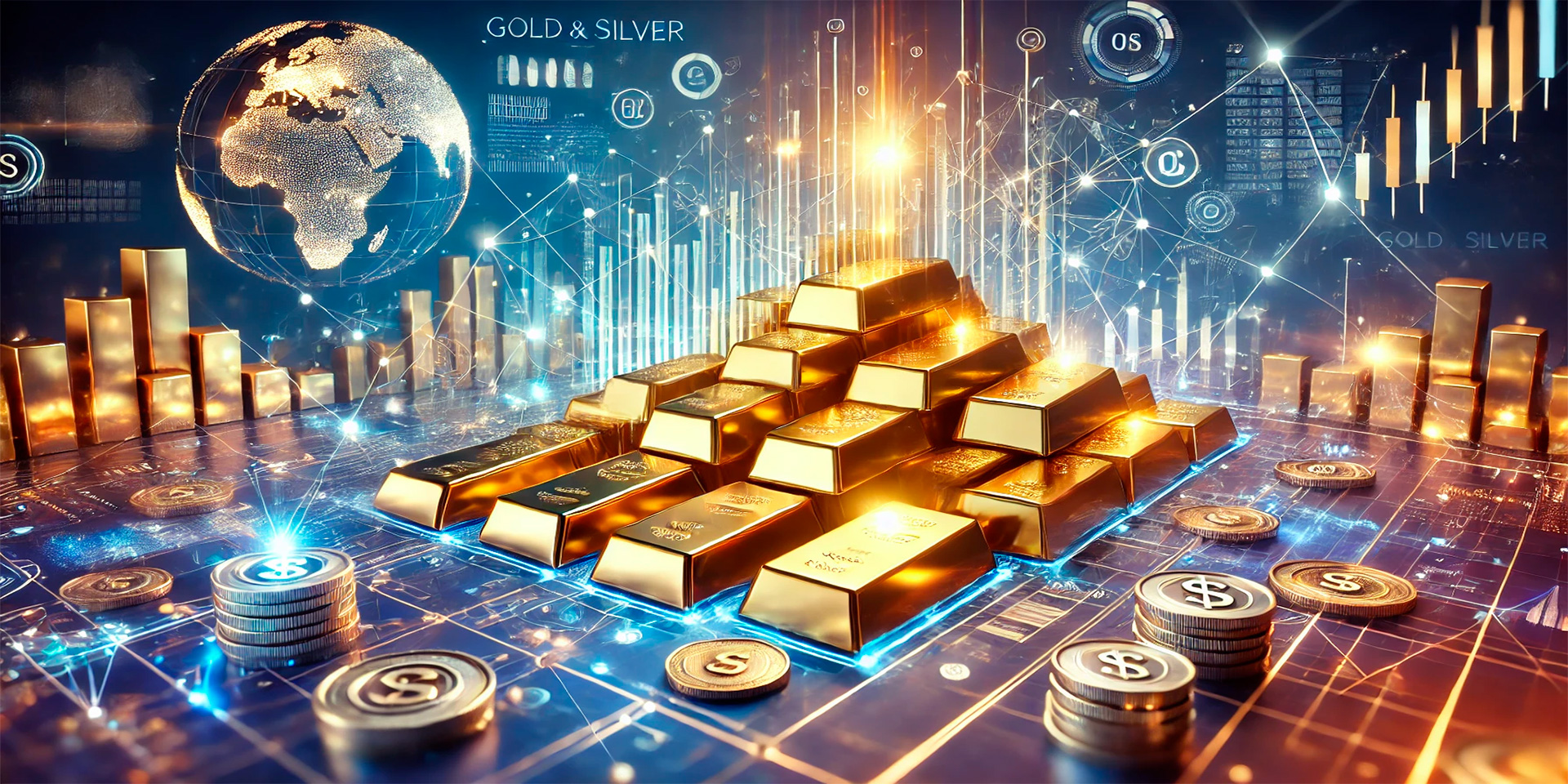
In times of economic uncertainty, inflation, or geopolitical instability, many investors turn to precious metals like gold and silver as safe-haven assets. Unlike stocks or bonds, precious metals have intrinsic value that remains largely unaffected by market volatility and inflationary pressures. This article provides practical tips on how to invest in gold and silver, helping you protect and grow your wealth in unpredictable financial climates.
The Role of Precious Metals in Wealth Preservation
Precious metals, particularly gold and silver, have been used for centuries as stores of value and a hedge against inflation. These metals are tangible assets, meaning they are not subject to the same market fluctuations as paper currencies or equities. They can help preserve purchasing power over time, particularly during periods of financial instability or market downturns.
1. Why Precious Metals are a Safe-Haven Investment
When financial markets experience volatility, investors often seek safe-haven assets—those that retain or increase in value during market turmoil. Precious metals have historically performed well during economic crises, geopolitical tensions, or periods of inflation.
Why gold and silver are considered safe havens:
- Intrinsic value: Gold and silver hold value irrespective of economic conditions, unlike fiat currencies, which can lose value through inflation or currency devaluation.
- Global demand: The demand for precious metals is consistent across various industries, from jewelry to electronics, and they are recognized universally as valuable assets.
- Low correlation with other asset classes: Precious metals often move independently of the stock market, making them an ideal diversification tool in times of financial uncertainty.

How to Invest in Gold and Silver
There are several ways to invest in precious metals, each with its own advantages and disadvantages. Whether you’re looking for physical ownership, exposure through financial products, or indirect investment in mining companies, there are options to suit your financial goals and risk tolerance.
1. Physical Gold and Silver
Buying physical gold and silver is one of the most direct methods of investing in these metals. This can include gold and silver bars, coins, and bullion, all of which can be stored securely either at home or in a vault. Physical precious metals provide a tangible asset, making them a popular choice for those who prefer to own their investments outright.
Pros of investing in physical metals:
- Ownership and control: When you own physical gold or silver, you have direct control over your assets, without relying on third parties like banks or brokers.
- Long-term store of value: Physical metals are a proven hedge against inflation and currency devaluation, especially in times of crisis.
- Global liquidity: Precious metals are universally recognized and can be easily bought, sold, or traded in any market.
Considerations for physical gold and silver investments:
- Storage and insurance: Storing physical precious metals requires a secure place, such as a safe deposit box, and insurance to protect against theft or loss.
- Premiums and fees: When purchasing physical metals, you may incur premiums over the spot price, as well as fees for storage and insurance.
2. Precious Metal ETFs and Mutual Funds
Exchange-Traded Funds (ETFs) and mutual funds that invest in gold and silver provide a way to gain exposure to these metals without physically owning them. These funds typically track the price of gold or silver, allowing investors to buy shares in the fund and benefit from price movements.
The advantages of investing in ETFs and mutual funds:
- Liquidity: ETFs can be bought and sold easily on the stock market, providing investors with liquidity and ease of access to their investments.
- Lower storage costs: Unlike physical precious metals, ETFs and mutual funds don’t require storage or insurance, as the metals are held by the fund or financial institution.
- Diversification: Some ETFs and mutual funds offer diversified exposure to both gold and silver, as well as to mining stocks, providing a broader exposure to the precious metals market.
Key considerations for ETFs and mutual funds:
- Management fees: ETFs and mutual funds typically charge annual management fees, which can eat into your returns over time.
- No direct ownership: Unlike physical metals, owning shares in a fund doesn’t give you direct ownership of gold or silver, and you may have less control over your investments.
3. Investing in Precious Metal Mining Stocks
Investing in the stocks of companies that mine precious metals is another way to gain exposure to the market. Mining stocks can offer leveraged exposure to the price movements of gold and silver, meaning they can increase in value more significantly than the metals themselves when prices rise. However, mining stocks also come with company-specific risks, such as management issues, regulatory challenges, and operational problems.
Benefits of investing in mining stocks:
- Higher potential returns: Mining companies can provide significant returns if they are successful in increasing production or if metal prices rise sharply.
- Dividend potential: Some precious metal mining companies pay dividends to shareholders, offering a potential income stream.
- Leverage to metal prices: Mining stocks often outperform the underlying metals in a bull market, providing an amplified return if gold or silver prices rise.
Risks to consider with mining stocks:
- Operational risks: Mining companies face risks related to exploration, production costs, and environmental regulations, which can affect their profitability.
- Stock market volatility: Mining stocks are subject to the same market risks as other equities, including price fluctuations unrelated to the performance of the metals themselves.
4. Futures and Options Trading
Futures and options contracts are financial derivatives that allow investors to speculate on the future price of gold or silver. These contracts provide an opportunity for investors to profit from price movements without owning the physical metals. While these financial products can offer high returns, they also carry significant risks due to leverage and market volatility.
How futures and options work:
- Futures contracts: A futures contract allows you to agree to buy or sell a specific amount of gold or silver at a predetermined price on a set date in the future.
- Options contracts: Options give you the right, but not the obligation, to buy or sell gold or silver at a specific price within a given time frame.
- Leverage: Futures and options often involve leverage, meaning you can control a large position with a small amount of capital, which increases both potential returns and risks.
Risks of trading futures and options:
- High risk of loss: Due to leverage, losses can exceed your initial investment, making futures and options a high-risk investment strategy.
- Complexity: These financial products are complex and may not be suitable for all investors, particularly those without experience in derivatives trading.

Tips for Investing in Precious Metals
When investing in gold and silver, it’s essential to adopt a strategic approach based on your investment goals, time horizon, and risk tolerance. Here are some practical tips to guide your investment decisions:
1. Diversify Your Portfolio
Precious metals can be an excellent way to diversify your investment portfolio and reduce risk. However, it’s important not to rely entirely on gold and silver. A well-rounded portfolio should include a mix of asset classes, such as equities, bonds, and real estate, to spread risk and ensure balanced growth.
2. Understand Market Cycles
The price of gold and silver can be volatile, driven by factors like inflation, interest rates, and global political events. It’s essential to understand the market cycles for these metals and avoid making impulsive decisions based on short-term price movements. Historical trends show that precious metals often perform well during times of economic uncertainty or when inflation is high.
3. Avoid Overexposure
While gold and silver are effective hedges against inflation and financial instability, overexposing your portfolio to precious metals can expose you to unnecessary risk. Limit your precious metal investments to a reasonable percentage of your total portfolio, depending on your financial goals and risk tolerance.
4. Stay Informed About Global Events
Precious metal prices are heavily influenced by global economic events, such as geopolitical tensions, financial crises, and changes in interest rates. Stay informed about current events and economic policies to anticipate potential price movements and make informed investment decisions.
Conclusion
Investing in gold and silver can provide a valuable hedge against inflation and economic instability, offering a stable store of value when other assets may falter. Whether you choose to invest in physical metals, ETFs, mining stocks, or derivatives, it’s crucial to understand the risks and benefits of each method. By diversifying your investments, staying informed about market cycles, and avoiding overexposure, you can successfully navigate the complexities of precious metal investment and protect your wealth in volatile financial climates.





